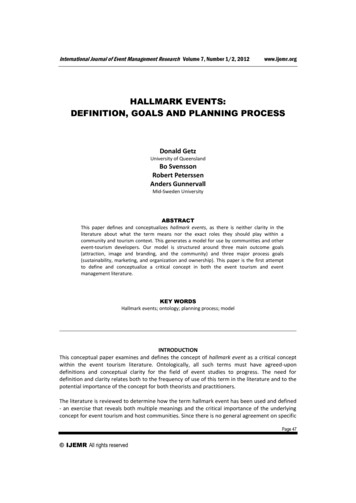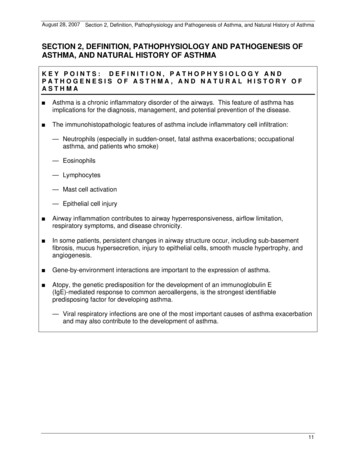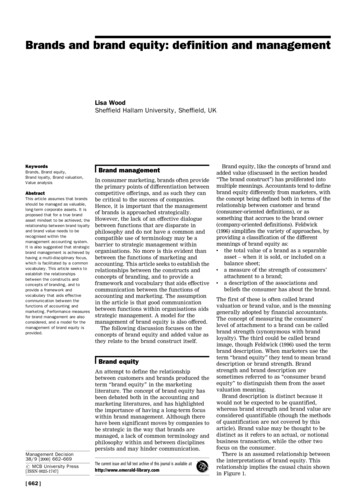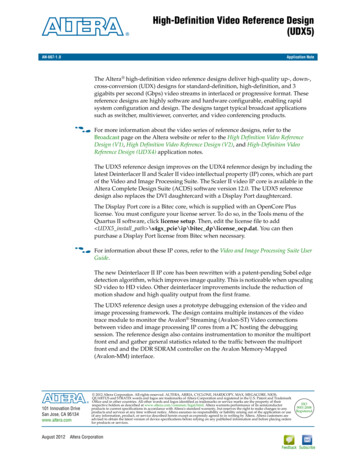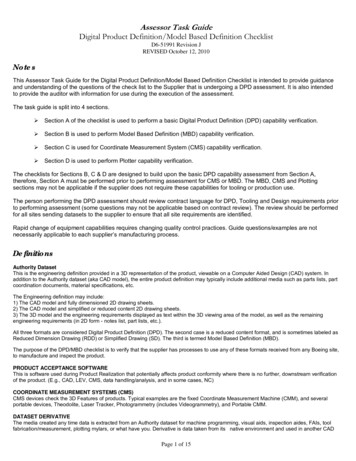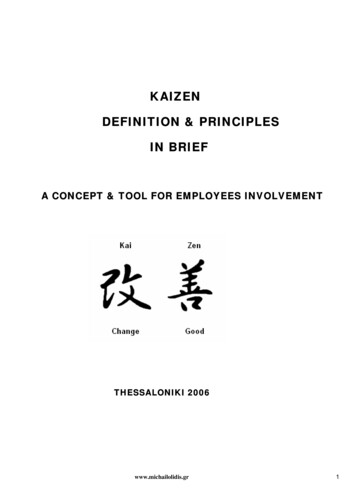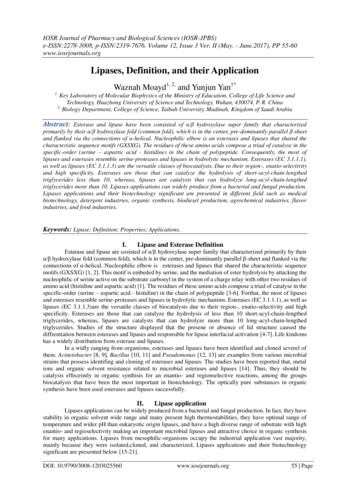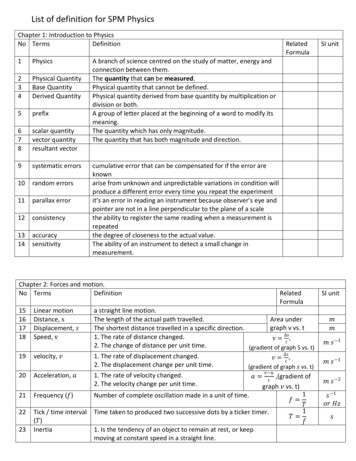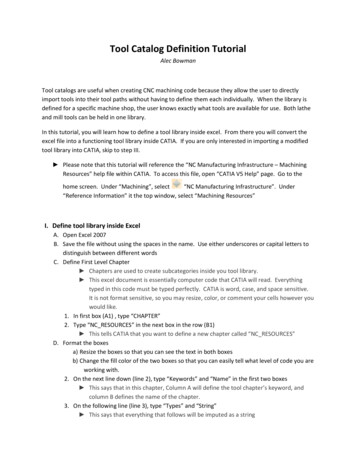
Transcription
Tool Catalog Definition TutorialAlec BowmanTool catalogs are useful when creating CNC machining code because they allow the user to directlyimport tools into their tool paths without having to define them each individually. When the library isdefined for a specific machine shop, the user knows exactly what tools are available for use. Both latheand mill tools can be held in one library.In this tutorial, you will learn how to define a tool library inside excel. From there you will convert theexcel file into a functioning tool library inside CATIA. If you are only interested in importing a modifiedtool library into CATIA, skip to step III. Please note that this tutorial will reference the “NC Manufacturing Infrastructure – MachiningResources” help file within CATIA. To access this file, open “CATIA V5 Help” page. Go to thehome screen. Under “Machining”, select“NC Manufacturing Infrastructure”. Under“Reference Information” it the top window, select “Machining Resources”I. Define tool library inside ExcelA. Open Excel 2007B. Save the file without using the spaces in the name. Use either underscores or capital letters todistinguish between different wordsC. Define First Level Chapter Chapters are used to create subcategories inside you tool library. This excel document is essentially computer code that CATIA will read. Everythingtyped in this code must be typed perfectly. CATIA is word, case, and space sensitive.It is not format sensitive, so you may resize, color, or comment your cells however youwould like.1. In first box (A1) , type “CHAPTER”2. Type “NC RESOURCES” in the next box in the row (B1) This tells CATIA that you want to define a new chapter called “NC RESOURCES”D. Format the boxesa) Resize the boxes so that you can see the text in both boxesb) Change the fill color of the two boxes so that you can easily tell what level of code you areworking with.2. On the next line down (line 2), type “Keywords” and “Name” in the first two boxes This says that in this chapter, Column A will define the tool chapter’s keyword, andcolumn B defines the name of the chapter.3. On the following line (line 3), type “Types” and “String” This says that everything that follows will be imputed as a string
4. Add a fill color to lines 2 and 35. Define the sub chapters inside of NC RESOURCESa) On line 4, type NC TOOLS in both column A and Bb) On line 5, type NC INSERTS in both column A and B This defines two subchapters inside of the NC RESOURCES chapter6. On line 6, type “END” to end the chapter declaration. Format this cell to look like rows 2and 3 This completes the NC RESURCES chapter definition. From here, we can define thetwo sub chaptersE. Define NC RESOURCES subchapter We will define three tools under NC TOOLS (external lathe tool holder, end mill, anddrill) and one NC INSERT (triangular insert). Additional tools can be define using thecategories described in “Machining Resources”1. Declare the first three lines (7 through 9) the in the same manner as lines 1 through 3,except this time title the chapter NC TOOLS The name of the chapter must be the exact same as it is defined in theNC RESOURCES subchapter definition (line 4)2. Create three subchapters on lines 10 through 12 with the labs “MfgExternalTool”,“MfgEndMillTool”, and “MfgDrillTool”. These syntaxes can be found in “Machining Resources” in the first line of each tooldescription3. End the chapter in the same manner as before4. Repeat step 1 through 4 to create the chapter named NC INSERTS with the subchapter“MfgTriangularInsert”.
F. Define the tools1. In box A19, type “ENDCHAPTER” to indicate that this is the final subchapter to be created2. In box B19, type “MfgExternalTool" to start the definition of the external lathe holder tool.Once again, be sure that this is the same as the declaration in the NC TOOLS chapter3. Apply a color fill matching line 1’s color to indicate that this is a new chapter definition The next two lines (20 and 21) give the characteristics of the tool. Please note thatthis tutorial does not define all the possible tool parameters. Many tool attributes(such as coolant requirements) may be left blank. These categories may be found inthe “Tool and Insert Holder Resources” help file. The categories are different foreach tool. To access the appropriate part of this help file, click the link at thebottom of each tool description in “Machining Resources”. The categories that areincluded in this tutorial are either required for tool definition or are highlyrecommended.4. In box A20, type “Keywords” and on the following line, type “Types” and then fill the boxeswith a color. The first line (line 20) declares the category. The second line (line 21) declares theunits that will be used to define the category. Some of the possible types of unitsare “Types”, “String”, Integer”, “deg”, “in”, and “mm”.5. The lines following the units line (before an “END” tag) are for actual tool definitions. Online 22, under the keyword category, type “External Lathe Holder” This category does not have a required syntax. There are only a few of thecategories have values that have restricted inputs for an individual tool description.These categories should be noted by a comment. All other categories are onlyrestricted to the units that are assigned to them. (For example, an ‘integer’ unit canhave 2, 8, or 9 as values, but not 3.45)6. Repeat this process across the row for the following categories, units, comments, andvalues.a) To add a comment, select the category you wish to commentb) Under the review tab, select“New comment”c) Type in your comment, and click out of the box when you are finished.
CategoryMFG NAMEMFG COMMENTUnitsStringStringMFG HAND STYLEStringMFG KAPPA RMFG INSERT ANGLEMFG CLEAR ANGLEMFG INSERT LGTHMFG SHK CUT WDTHMFG SHANK HEIGHTMFG SHK LENGTH 1MFG SHK LENGTH 2MFG SHANK WIDTHMFG TRAILING ANGMFG LEADING ANGLEMFG MAX REC DPTHdegdegdeginininininindegdeginCommentRIGHT HANDLEFT HANDNEUTRALValueTNMG 322 M3TNMG 322 M3LEFT HAND95600.651.523.51.51.525951.181 The descriptions of each one of these elements can be found in either “MachiningResources” or “Tool and Insert Holder Resources”7. End the chapter with another “END” command on line 238. Repeat steps 1 through 7 on lines 24 through 40 to define the remaining tools with thefollowing data Note that we will define three different end mill tools. Each tool gets its own line.Also note, some values are left blank. In this process, copy and paste can be veryhelpful, but remember to change the appropriate fields when it is needed. Don’tforget to keep saving your work.
CategoryUnitsKeywordsStringMFG NAMEStringMfgEndMillToolCommentMFG NOMINAL DIAM inMFG OVERALL LGTHinMFG LENGTHinMFG CORNER RADinMFG BODY DIAMinMFG MACH QUALITYStringMFG NB OF FLUTESIntegerMFG TOOTH MATStringMFG HAND STYLEStringROUGHFINISHEITHERValueEnd MillEnd MillEnd Mill1/8 in3/16 in3/8 375EITHEREITHERROUGH24HIGH SPEED STEELCOATED HIGH SPEED STEEL HIGH SPEED STEELCARBIDEHIGH SPEED STEELCOATED CARBIDEHIGH SPEED STEELOTHERRIGHT HANDRIGHT HANDRIGHT HANDLEFT HANDRIGHT HAND
CategoryKeywordsMFG NAMEMFG NOMINAL DIAMMFG OVERALL LGTHMFG LENGTHMFG CUT LENGTHMFG TL TIP LGTHMFG BODY DIAMMFG CUT ANGLEUnitsStringStringinininininindegMFG MACH QUALITYStringMFG NB OF FLUTESIntegerMFG TOOTH MATStringMFG HAND STYLEStringCategoryKeywordsMFG NAMEMFG COMMENTMFG NOSE RADIUSMFG INSERT LGTHMFG INSCRIB DIAMMFG INSERT THICKMFG CLEAR ANGLEUnitsStringStringStringinininindegMFG MACH QUALITYStringMFG INSERT MATString9. Save the file.G. Prepare the file for export.1. Go to “Save lDrill #7 -- .201.20131.51.5.06.201118EITHER2HIGH SPEED STEELCOATED HIGH SPEED STEELCARBIDEHIGH SPEED STEELCOATED CARBIDEOTHERRIGHT HANDRIGHT HANDLEFT HANDMfgTriangularInsertCommentValueTriangular InsertTNMG 322 M3TNMG 322 M3.032.65.5.1250ROUGHFINISHEITHEREITHERHIGH SPEED STEELCOATED HIGH SPEED STEELCARBIDECOATED CARBIDECOATED CARBIDEOTHER
2. Save the file as a “CSV (MS-DOS) (*.csv)” file3. Accept all the dialogue boxes.H. You have now finished defining the tool library inside ExcelII. Create the Macro script to import the .csv file into CATIAA. Open a new file in “Notepad”B. Paste the following script into the documentLanguage "VBSCRIPT"Sub CATMain()InputFile "T:\Folder 1\Folder 2\Folder 3\Tool Library.csv"OutputFile "T:\Folder 1\Folder 2\Folder 3\Tool Library.catalog"Dim Catalog As Documentset Catalog teCatalogFromcsv InputFile, OutputFileCatalog.CloseEnd SubC. Change the “InputFile” to the location of your .csv tool library
D. Change the “OutputFile” to the locaton you want your tool library to be saved. Be sure that theoutput file name ends with a “.catalog” I recommend sending the output file to the same location as .csv file for easy location.Once the file has been created, you will move it to the proper directory within CATIA’sfile structure.E. Save the Notepad file. End the file name with “.CATScript”III. Importing the tool catalog into CATIA.A.B.C.D.Open CATIA V5Open “Tools - Macro - Macros ”Click the “Select” buttonLocate your script file If there are multiple script files in the containing folder, all of them will be available inthe “Available macros” window. Be sure to select the appropriate script before runningit.E. Click the “Run” button1. The Macro dialogue box will disappeared and nothing else will appear to have happened.F. Open the destination folder (defined in the script file)1. You may have to refresh the window
G. If you see your .catalog file, congratulations. You have successfully created a CATIA tool library.If this happened, move to step V.IV. TroubleshootingA. If you do not have a .catalog, file there is either a mistake in your .csv file or your script file1. If you do not see a .report file, your error is in your script file. To fix this, review step II.2. If you see a .report file, your error is within your .csv filea) Open the .report file in “Notepad”b) Scroll down to the bottom of this file. There should a very brief deception of where tolook for your problemc) Open your original Excel file (the .xlsx file)d) Locate the error and modify the offending linee) Resave the file as a .csv You may get an error saying that the file is being used by another program. Ifthis is the case, close CATIA. This should fix the problem3. Once the modifications have been made, repeat step IIIV. Place the new tool catalogue in the appropriate directoryA. Open CAITA if it is not already runningB. Go to “Tools - Options ”C. Select the “Resources” tab under “Machining”D.E.F.G.H.Select all the text in the “Catalogs and Files” field.Copy the text (Ctrl C)Open a new “Window Explorer” windowPaste the copied text into the navigation bar and push enterOpen “ /Manufacturing/Tools/” and place your created catalog inside the folder.
VI. Using your catalogue This procedure is relevant when defining machining operations within CATIA.This creating process is covered in separate tutorials.A. Open the “Part Operation” dialogue box by double clickingB.C.D.E.in the design tree.Select the“Machine” iconUnder the “Tooling” tab, select your tool catalog from the “Tools catalog” dropdown menuSelect “OK” in both of the open windowsWhen you need to insert a tool into your machine operation, under the tooling tab (in themachining operation dialogue box for which you need the tool), click the“Select a tool”button.F. Your tool library should open. Select the appropriate tool, and then continue your machinedefinition procedure.
Tool Catalog Definition Tutorial Alec Bowman Tool catalogs are useful when creating CNC machining code because they allow the user to directly import tools into their tool paths without having to define them each individually. When the library is defined for a specific machine shop, the user knows exactly what tools are available for use. Both lathe and mill tools can be held in one library .
